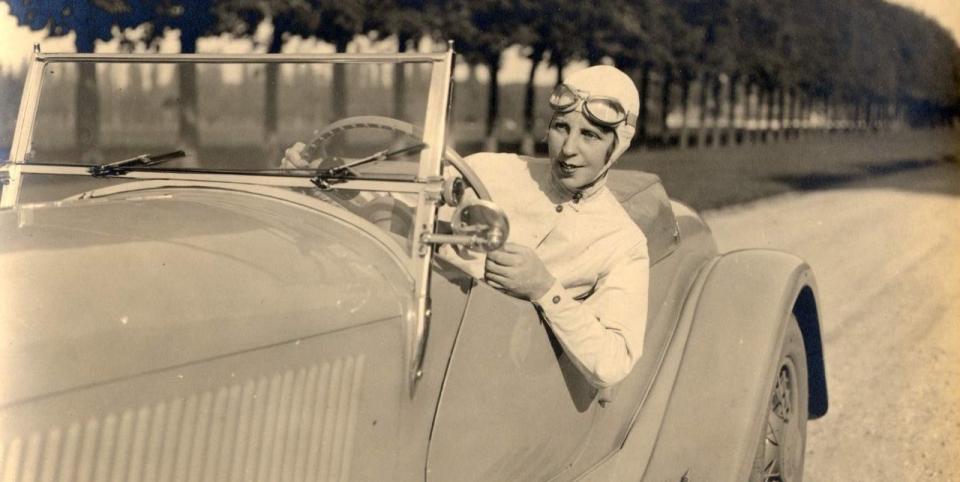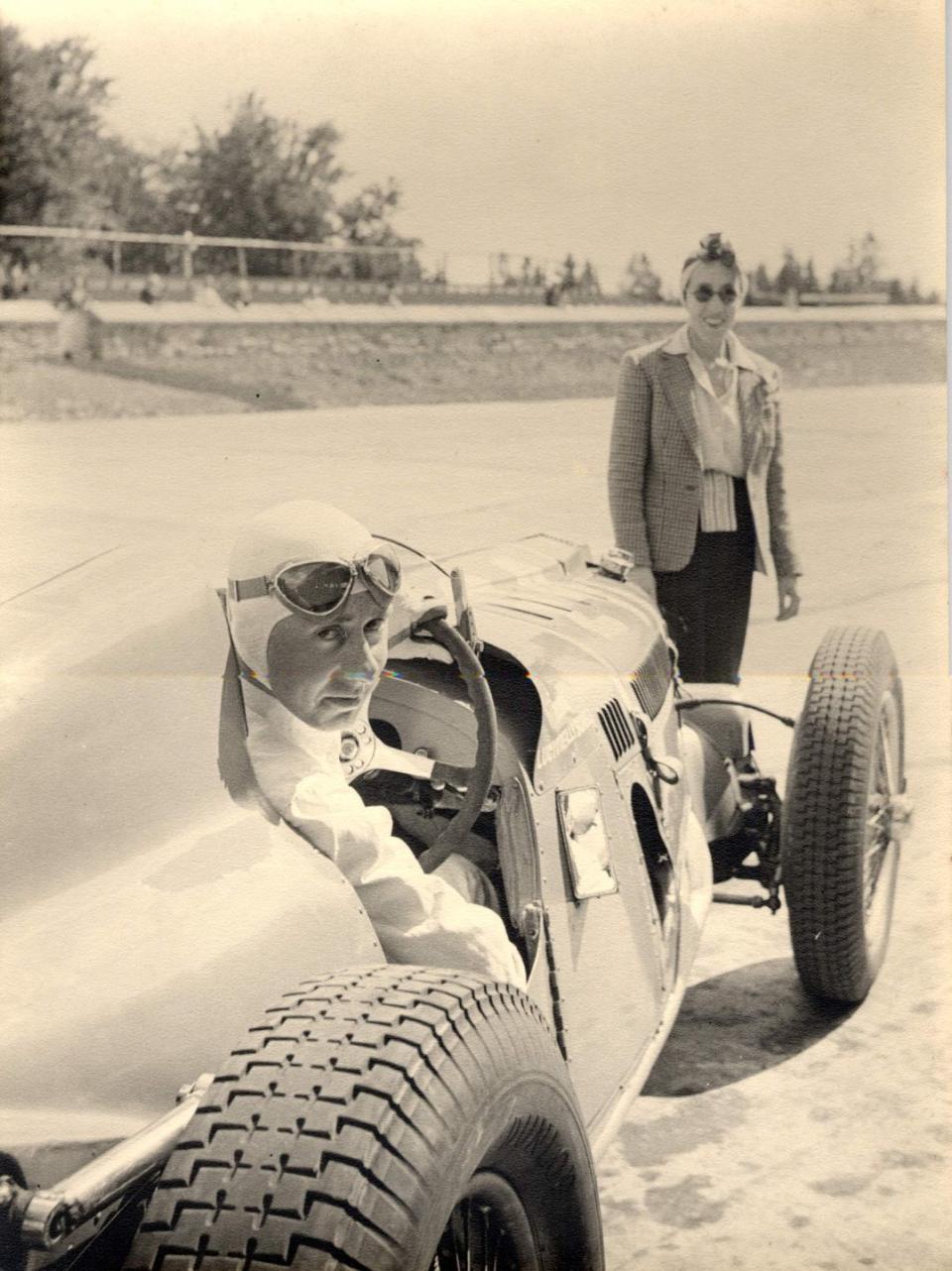Lucy Schell: The Pioneering Rally Driver Who Beat the Nazis

This story is based on the book Faster: How a Jewish Driver, an American Heiress, and a Legendary Car Beat Hitler's Best, available now.
If high society had its way, Lucy Schell would have attended the toniest schools, toured the capitals of Europe, married dynastically and, until her death in 1952, devoted her inherited fortune to hosting teas and flapper parties.
She moved to Paris instead and became a rally driver.
Schell knew full well that her gender would limit her as a driver, however, so the American heiress found another way to buck convention. In 1936, she became the first woman to own and operate a full-fledged Grand Prix racing team.
In the handful of articles about her, there's no mention that she helped design and develop the team's growling 12-cylinder Delahaye 145s, which started winning races almost immediately. The photos show her posing with her cars in high heels and haute couture.
Behind her fixed smiles, however, Schell harbored one almost unthinkable ambition. She wanted to beat Mercedes in a Grand Prix race. And in 1938, beating the lavishly funded Mercedes team meant flinging oil in Adolf Hitler's face.
Lucy Schell liked the sound of that.
Her largely forgotten places her on a list of pioneering women of the last century who never got their due—the NASA mathematician Katherine Johnson of Hidden Figures comes to mind.
Schell's story was largely overshadowed by World War II, but it was also obscured by a unique problem that only reinforces the magnitude of her achievements. At a Gran Prix in Pau, France in 1938, Schell's Delahaye team gave Hitler such an emphatic licking that he later tried to have the entire event erased from the historical record.
The victory itself was stunning and brazen, but that was only the half of it. René Dreyfus, the champion driver Schell handpicked for the job, had been expressly chosen to poke the Fuhrer, too. Dreyfus was Jewish.
"The amazing thing about this story is that a woman of that era used her fortune the way she did," Sam Mann, a prominent U.S. classic-car collector, told me. "She had such courage, and a sense of mission."
Born Lucy O'Reilly and raised partly in France, Schell was always irrepressible. When World War I cut short her Grand Tour of Europe, she declined to return home, opting to volunteer at a military hospital in Paris. The horrors she saw there helped inform her opinion of Hitler's warmongering.
After the war she married an American diplomat's son, Laury Schell, and had two boys. When her husband participated in an auto race in 1927, she fell hard. She spent some of her fortune on racing Bugattis and Alfa Romeos and competed in many rallies, nearly winning one while driving with a fractured arm.
Meanwhile, in Germany, Hitler rose to power and announced a plan to reinvigorate Germany's auto industry and dominate racing. Money flowed to Mercedes and its rival, Auto Union, and their Grand Prix cars, nicknamed Silver Arrows, began trouncing all entrants from France, Italy, Great Britain and the U.S. Propaganda minister Joseph Goebbels bragged that the Reich's drivers were "swift as greyhounds, tough as leather, strong as Krupp steel."
By 1936, Schell had seen enough.
The Nazis were running roughshod over global politics in addition to motor sport, and she believed they needed to be humbled. She hung up her racing overalls and decided to launch a Grand Prix team from scratch.
Delahaye was an unlikely partner. The old French firm had been on the verge of bankruptcy and its vehicles were known for reliability, not speed. A Delahaye was the perfect car to drive "in a funeral procession," one critic said.
Schell was undeterred. "I will finance the project from top to bottom: design, construction, development, the racing itself," she told Mr. Weiffenbach. "I'm offering you an opportunity which I'm sure isn't available to any other firm… Now what do you say?"
By 1936, fascism's rise in Europe had nearly broken René Dreyfus, who'd been banned from competing with the top teams. Lucy knew he had the skill to win any race, but the larger question was if he had the fire anymore to do it.

Outthinking Mercedes was no small task. Delahaye's engineers struggled at times and Schell aggressively pushed them. At track-testing sessions, she often took the wheel herself. In other moments, she had to prop up Dreyfus's confidence.
In 1937, Schell's team had its first breakthrough; winning a speed contest for French Grand Prix cars called the Million Franc Prize. All the credit went to Dreyfus and Delahaye. Schell's name was barely mentioned.
As Europe edged toward war in 1938, no French car or driver had beaten the Germans in a Grand Prix race since Hitler's initiative began. When Schell entered her cars at Pau, Mercedes barely counted them a challenge. Journalists and bookmakers thought she stood no chance.
At the end of 100 laps, however, Dreyfus hadn't just taken the checkered flag. He'd beaten the closest Mercedes by almost two minutes.
Hitler invaded France in 1940 and before fleeing with her one family, Schell secured safe passage for Dreyfus to America, using his participation in the Indianapolis 500 as an excuse. Nazi tanks rolled into Paris shortly thereafter.
That spring, a Gestapo officer accompanied by several subordinates strode into the colonnaded headquarters of the Automobile Club de France and headed straight to the library. "Bring me all the race files," he told the young librarian.
The records were boxed up and brought out on a cart to be hauled away. "Go home and never return here, or you'll be arrested" the officer told the clerk. "We will write the history now."
Those records were never found, and their absence succeeded, to some degree, in obscuring the story of Schell, Dreyfus and Delahaye. But one thing is clear: if Hitler hoped the records would lead him to the cars themselves, he was gravely disappointed.
Once again, Lucy Schell was way ahead.
On a chilly morning last February in Englewood, N.J., a small group of mechanics and car enthusiasts gathered outside Mr. Mann's oversize garage, which houses a renowned collection of rolling French sculpture; Facel-Vegas, Bugattis and Hispano Suizas.
The silence was broken by a series of winding and sputtering noises, followed by a thundering roar—the sound of internal combustion being conducted at scale. It's the same engine note Lucy Schell and Rene Dreyfus heard in the pits at Pau in 1938.
The fact that any of Schell's four Delahaye 145s survived the war is another small miracle. There was little doubt Hitler wanted them seized and destroyed. But before the Nazis rolled into Paris in 1940, Schell and her partners had taken precautions.
Just as curators hid the treasures of the Louvre, Schell and her production chief, Charles Weiffenbach, sold the cars off to protect them. Two are known to have been kept during the war by a coachbuilder, Henri Chapron, who disassembled them and scattered their parts amid others in his shop. The others were likely hidden in barns or caves outside the city.
Chapron's rebodied cars were later acquired by the automotive museum of Peter Mullin in Oxnard, Calif. He also discovered a third 145 in derelict shape in the garage of a French chateau and had it restored to racing shape. The fourth received a postwar convertible roadster body from French coachbuilder Franay and was later bought by Mr. Mann, an industrial designer.
There is some dispute about which car Dreyfus actually drove at Pau, with both Mr. Mann and Mr. Mullin claiming possession. One thing is certain, though. The rebodied Delahaye that rumbled out of Mr. Mann's garage into the morning sunlight contains the same bits fabricated and assembled by the team that humiliated Hitler.

Mr. Mann's light blue Delahaye is a work of genius on two levels: its sweeping, sculptural coachwork earned it the title "most elegant cabriolet" at the prestigious Pebble Beach Concours in 2015. Below the hood, there's a magnesium engine block and an ingenious electromagnetic gearbox that were both ahead of their time. The acceleration will throw you back in your seat.
Its value is estimated well into the millions.
With its new skin, this Delahaye has actually evolved into a more-fitting tribute to Lucy Schell. It's refined and beautiful on the surface but below the surface; fast, fearless and competitive.
Neal Bascomb is an award-winning and New York Times bestselling author.
You Might Also Like

 Yahoo News
Yahoo News 